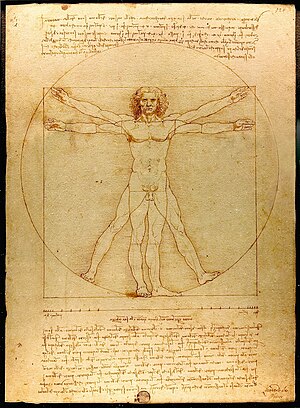Vitruvian Man
 |
|
| Artist | Leonardo da Vinci |
|---|---|
| Year | c. 1490 |
| Type | Pen and ink with wash over metalpoint on paper |
| Dimensions | 34.6 cm × 25.5 cm (13.6 in × 10.0 in) |
| Location | Gallerie dell'Accademia, Venice |
The Vitruvian Man (Italian: Le proporzioni del corpo umano secondo Vitruvio, which is translated to "The proportions of the human body according to Vitruvius"), or simply L'Uomo Vitruviano ([ˈlwɔːmo vitruˈvjaːno]), is a drawing by Leonardo da Vinci around 1490. It is accompanied by notes based on the work of the architect Vitruvius. The drawing, which is in pen and ink on paper, depicts a man in two superimposed positions with his arms and legs apart and inscribed in a circle and square. The drawing and text are sometimes called the Canon of Proportions or, less often, Proportions of Man. It is kept in the Gabinetto dei disegni e stampe of the Gallerie dell'Accademia, in Venice, Italy, under reference 228. Like most works on paper, it is displayed to the public only occasionally.
The drawing is based on the correlations of ideal human proportions with geometry described by the ancient Roman architect Vitruvius in Book III of his treatise De architectura. Vitruvius described the human figure as being the principal source of proportion among the classical orders of architecture. Vitruvius determined that the ideal body should be eight heads high. Leonardo's drawing is traditionally named in honor of the architect.
This image demonstrates the blend of mathematics and art during the Renaissance and demonstrates Leonardo's deep understanding of proportion. In addition, this picture represents a cornerstone of Leonardo's attempts to relate man to nature. Encyclopaedia Britannica online states, "Leonardo envisaged the great picture chart of the human body he had produced through his anatomical drawings and Vitruvian Man as a cosmografia del minor mondo (cosmography of the microcosm). He believed the workings of the human body to be an analogy for the workings of the universe."
...
Wikipedia
